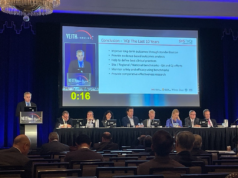A study presented at the European Society for Vascular Surgery’s annual meeting (ESVS; 25–28 September, Valencia, Spain) has concluded that mechanochemical ablation with concomitant ambulatory phlebectomy (MOCAP) results in greater early improvement in quality of life and significant reduction in reintervention rates when compared to mechanochemical ablation (MOCA) alone.
Presenter Abduraheem Mohamed (Hull Royal Infirmary, Hull, UK) explained that MOCA is becoming increasingly popular as a treatment method for varicose veins, perhaps because it is purported to be less painful than thermal ablation. However, he questioned what should be done with the varicosities once the axial reflux has been treated. There are two schools of thought on this—some argue that you should treat them in the same sitting, with whatever means are available, and others argue that you should leave them alone because they will regress and become asymptomatic.
The advocates of MOCA, he indicated, say that the scleroscent distributes into the tributaries after the axial reflux has been treated, which might occlude them sufficiently to eliminate the need for them to be further treated. At the moment there is no evidence for either approach with regards to MOCA.
The aim of the study presented was therefore to compare the clinical and technical outcomes of MOCA alone against MOCA with concomitant ambulatory phlebectomy.
The investigators performed a nonrandomised comparative study where patients self-selected the arm in which they were enrolled—either MOCA alone or MOCA with phlebectomy. The primary outcome was the disease-specific Aberdeen Varicose Veins Questionnaire and the secondary outcomes (measured at one, six, 26 and 52 weeks) included VCSS, EQ5D, complications and technical outcomes.
Mohamed reported that 33 patients were included in the MOCA group and 50 patients in the MOCAP group. He said that the baseline characteristics were similar between the two groups in terms of the severity of the disease, the diameter of the vein and quality of life scores, with the only noticeable difference found in age, where older patients chose MOCA alone.
In terms the primary endpoint, Mohamed explained that while at baseline and at one week the two groups remained similar, at six weeks, those who underwent phlebectomy, were ahead in terms of quality of life and performed better. This remained at six months, and only levelled out a year later. “It takes about a year for those who have undergone MOCA alone to catch up in terms of quality of life after treatment,” he clarified.
As it relates to secondary outcomes, the investigators found a higher rates of reinterventions in the MOCA alone group (18%, n=6) compared to the MOCAP group (4%, n=2), p=0.032. The advantage of the MOCA alone group, Mohamed said, was that the procedure time was 15 minutes shorter and less painful. However, looking at the return to work time and the time to return to normal activity, he pointed out that it was the same in both groups.
When compared to MOCA alone, MOCAP results in greater early improvement in quality of life, significant reduction in reintervention rates, modest increase in procedure duration and an increase in procedural pain of questionable significance.
As for whether the addition of phlebectomy makes the procedure more difficult for the operator, Mohamed explained that the procedure was carried out by trainees and can therefore be considered relatively straightforward.









